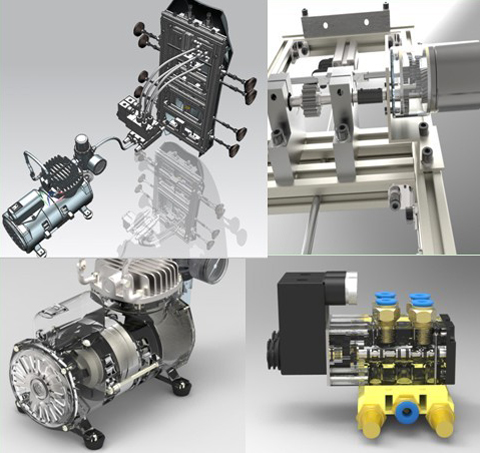The object of orthodontics research is three-dimensional cranial, maxillofacial, and facial structures. Traditional methods of examination have not fully met the requirements of modern orthodontic diagnosis and design. With the rapid development of digital technology, the methods and concepts of clinical diagnosis, design and treatment of orthodontics have undergone rapid changes, which have continuously promoted the improvement of the efficiency and level of orthodontic clinical treatment, and made the orthodontic clinical diagnosis and treatment process more Accurate, scientific, convenient and safe. Now I discuss the application of digital technology in orthodontic diagnosis and treatment design, and hope to help orthodontists understand the digital technology in orthodontic field.
First, the application of three-dimensional digital technology in orthodontic examination and diagnosis
1. 3D cephalometric analysis:
X-ray cephalometric measurement is an important means of orthodontic diagnosis and scientific research, and its accuracy due to overlap, distortion, deformation and irregular amplification can affect the accuracy of measurement results. The cone beam CT radiation is smaller than the traditional CT, no distortion, enlargement and overlap. The three-dimensional cephalometric measurement based on the cone beam CT image can accurately reflect the three-dimensional relationship of the craniofacial structure. The traditional cephalometric measurement has a mature system such as the head locator and the natural head position to help establish the coordinate system and obtain the horizontal and sagittal reference frame. The three-dimensional reconstruction image of the cone beam CT lacks the positioning coordinate system. In the three-dimensional measurement, the angles in the original two-dimensional measurement are mostly converted into the face angle, and how the face angle is interpreted is still immature. The new 3D measurement coordinate system should include coordinate origin, datum plane, measurement marker points, 3D reference plane and measurement items. Liang Shuran et al. explored the repeatability and reliability of marker point location in three-dimensional images of cone beam CT, and selected 30 high-reliability three-dimensional marker points from 39 commonly used bone and tooth landmarks. Based on the basis, 32 highly reliable measurement items were selected, including SNA angle, SNB angle, ANB angle, Y-axis angle, jaw angle, face angle, mandibular plane angle and Wits value. Through these measurement items, the sagittal, coronal and vertical measurements of the upper and lower jaws and teeth can be performed to provide a basis for the establishment of three-dimensional cephalometric analysis standards. It is worth noting that when using three-dimensional cephalometric analysis with cone beam CT, the meaning of more measurement items is different from that of two-dimensional cephalometric measurement. For example, the Wits value includes both the sagittal relationship of the upper and lower jaws and also the coronal relationship. The mandibular plane angle not only reflects the vertical inclination angle of the mandibular plane, but also the angle of the lower mandible and the median sagittal plane. Therefore, the difference between the same measurement project in 3D and 2D cephalometric measurements remains to be further studied.

2. Digital dental model:
The dental model plays an important role in orthodontic examination and diagnosis. At present, the most commonly used plaster model is the plaster model, but the plaster model has the disadvantages of easy wear, easy loss, and large physical storage space. The three-dimensional digitization technology of the dental model refers to the spatial three-dimensional coordinate data of a series of discrete points on the surface of the dental jaw or the surface of the plaster model through a specific three-dimensional scanning device and a three-dimensional reconstruction algorithm. On this basis, data processing and surface reconstruction are performed to obtain a Close to the prototype, a three-dimensional digital dental model containing shape information. The methods of digitizing the dental model include laser scanning, CT image reconstruction, contact coordinate measuring instrument and chromatography. Among them, chromatography is the most commonly used. It can process multiple jaw models at a time, and only requires manual intervention when preparing the cutting specimen. The cutting and scanning process can be completed automatically, and the degree of automation is high. The image reconstruction process is supported by mature algorithms. The acquired digital three-dimensional dental model can truly reflect the tiny anatomical structure in the oral cavity with high precision and low production cost. However, the tomographic scanning method takes a long time and belongs to destructive scanning. Its accuracy depends on the thickness of each cutting. The process of acquiring data is destructive. Once the scanning is completed, the original model no longer exists, and the scanning cost of a single model is high. Moreover, the difference in the performance of the silicone rubber impression material, the difference in the skill level of the operator when the impression is taken, the damage and deformation during the delivery of the impression can affect the accuracy of the digitized dental model after the chromatographic scan. In recent years, with the development of digital technology, intra-oral direct scanning technology has emerged, which avoids the discomfort caused by traditional manual modulo and the inaccuracy of impression materials, and transmits files to invisible through built-in wireless devices. The correction design company carries out subsequent processing. The relatively cumbersome steps of taking the impression and sending the impression are omitted, which makes the operation simple, convenient and fast; the three-dimensional information of the dental jaw is obtained directly from the patient's mouth, and the disadvantages of the accuracy of the digital dental model caused by the deformation of the model are avoided. It is a new digital method for dental jaw model. Direct digital scanning to obtain a digital model is a non-invasive acquisition method of dental jaw model, which improves the speed and accuracy of model measurement. The obtained digital model is easy to store and does not occupy space. The digital model is convenient for transmission, which is conducive to remote consultation, and can simulate orthodontic tooth movement for personalized appliance design.
PPE Gloves Disposable For Foods
Ppe Gloves Disposable For Foods,Ppe Gloves For Foods,Foods Ppe Gloves Disposable,Single Use Gloves Should Be Worn
HOLIK ASIA GROUP CO.LTD , https://www.holikasia.com